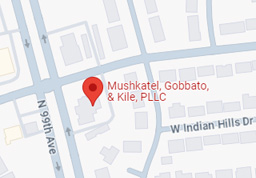Arizona Motorcycle Laws

From the Mount Lemmon Loop to the Coronado Trail to the Cottonwood Canyon Run, Arizona has many scenic rides for motorcyclists to enjoy. Unfortunately, motorcycle accidents frequently happen in our state. When they do, motorcyclists often suffer serious and life-altering injuries. These injuries are due to the fact that motorcyclists are afforded little protection in a crash.
Arizona regulates the use of motorcycles and places important safety requirements on riders. Motorcyclists must ensure that they operate in compliance with state motorcycle laws. After all, violations of the laws can lead to tickets and fines, and they can be used against motorcyclists in injury cases. For instance, a defendant in a personal injury case could argue for reduced damages if a victim in a motorcycle accident suffered injuries that may have been caused or worsened by the victim’s failure to wear a helmet as required by state law.
Did you suffer severe injuries or lose a loved one in a motorcycle accident in the Greater Phoenix area? You will want to have a knowledgeable personal injury attorney assist you in the handling of your injury claim. Mushkatel, Gobbato, & Kile, P.L.L.C. has almost half a century of combined legal experience. Our lawyers will provide a complete evaluation of your case when you call or reach us online to schedule a consultation about your case.
What Are the Motorcycle Gear Requirements in Arizona?
The Arizona Department of Transportation states in the Motorcycle Operator Manual that safety equipment required for motorcycle operators and passengers includes a U.S. Department of Transportation approved helmet if the person is under the age of 18. A motorcycle also needs to have at least one horn capable of emitting sound a minimum of 200 feet.
Riders are encouraged to equip motorcycles with both hand and foot brakes. However, Arizona law requires only one brake. A minimum of one rearview mirror is also mandatory.
Motorcycle handlebars must be positioned so that the hands of the operator are not above the operator’s shoulder height when he or she sits on the seat and has hands on the handlebar grip. Seats and footrests are also required for motorcycle operators.
Arizona encourages motorcyclists to use their headlights on high beams during daylight hours in order to maximize their visibility. A motorcyclist can use a modulating headlight during the day when the light modulates a minimum of 200 cycles per minute.
What are The Helmet Laws in Arizona?
As stated above, Arizona law requires all motorcycle operators and passengers under 18 years of age to wear a protective helmet. Motorcycle operators also must wear protective glasses, goggles or a transparent face shield (unless the motorcycle is equipped with a protective windshield). Arizona does not consider windscreens on sport-style motorcycles to be protective windshields. Fines for helmet violations could cost hundreds of dollars. Other equipment violations can also result in substantial fines.
Helmets are widely acknowledged to help reduce the chances of a rider suffering a serious head injury or traumatic brain injury. For this reason, our attorneys encourage all motorcycle operators and passengers of all ages to wear helmets when they ride. Your health and safety are too important.
What Are Arizona Motorcycle Passenger Laws?
A seat, footrests, and handrails are required for passengers of motorcycles in Arizona. They must also be able to rest their feet on the foot pegs. A motorcyclist who has a learner’s permit is not allowed to carry passengers.
When a motorcycle passenger is injured in an accident, the passenger may have somewhat complicated legal claims. If a motorcycle crash is caused by another motorist’s negligence, an injured passenger may be entitled to compensation from that negligent driver. If an accident is the result of the motorcycle operator’s negligence, then the motorcyclist (or the motorcyclist’s insurance company) will be responsible for covering the costs of the victim’s injuries. In some crashes, another driver and the motorcycle operator may both be liable for the passenger’s injuries.
Does Arizona Have Noise Laws For Motorcycles?
Under Arizona law, a person cannot operate or permit the operation of a motorcycle that is not equipped with the manufacturer’s original muffler or other original noise reduction equipment, or with a replacement muffler or replacement noise reduction equipment capable of reducing the noise levels below maximum operating noise levels. The law provides that a person cannot use a muffler cutout, bypass or similar device on a motorcycle in Arizona.
The maximum sound levels in Arizona are measured in A-weighted decibels, or dB(A). The decibel limits for motorcycles made before 1972 are:
- 84 dB(A) if moving slower than 35 mph
- 88 dB(A) if moving 35 mph or faster.
If a motorcycle was made between 1972 and 1980, the maximum sound levels are:
- 79 dB(A) if moving slower than 35 mph
- 82 dB(A) if moving faster than or equal to 35 mph but slower than 45 mph
- 86 dB(A) if moving faster than 45 mph.
On motorcycles made after 1980, the maximum sound levels are:
- 76 dB(A) if moving slower than 35 mph
- 80 dB(A) if moving faster than or equal to 35 mph but slower than 45 mph
- 83 dB(A) if moving faster than 45 mph.
As a motorcyclist, it is critical to know the state motorcycle laws so that you don’t injure yourself or anyone else.
Is Lane Sharing Legal in Arizona?
Lane sharing refers to motorcyclists operating side by side with a car or with another motorcycle in the same lane of traffic. In Arizona, a person cannot operate a motorcycle more than two abreast in a single lane. Lane splitting often involves a motorcyclist riding between rows of stopped or slowed traffic. Arizona strictly forbids this practice.
Currently, California is the only state with legalized lane splitting. In May 2015, the Los Angeles Times reported that a University of California Berkeley study had reviewed 6,000 motorcycle-involved traffic collisions between June 2012 and August 2013. The researchers found that “lane-splitting motorcyclists were considerably less likely to experience serious injury from their accidents than motorcyclists who were not lane-splitting at the time of their collisions.” Still, lane splitting remains illegal in Arizona.
Get Help from an Experienced Arizona Motorcycle Accident Lawyer Today
If you suffered serious injuries, or if your loved one was killed in a motorcycle crash in Arizona, it is important to get legal representation as soon as possible. Mushkatel, Gobbato, & Kile, P.L.L.C. has office locations in Sun City, Scottsdale, Glendale, Peoria, and Surprise. Contact us today for a consultation.













